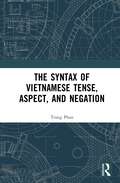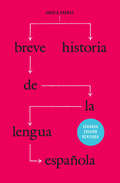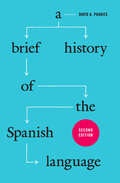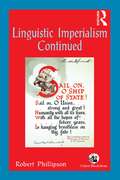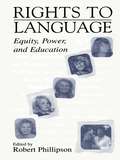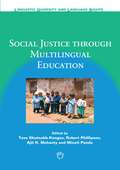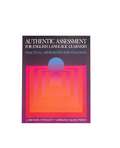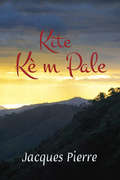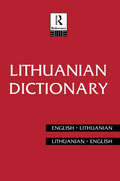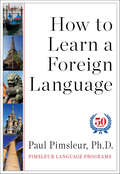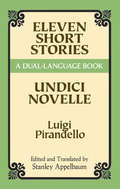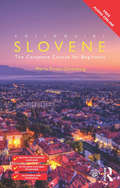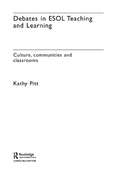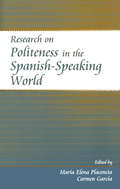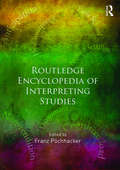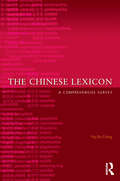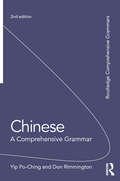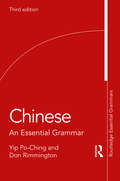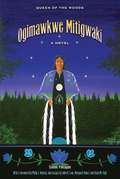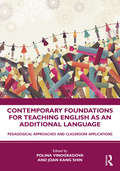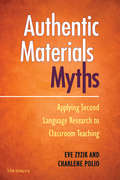- Table View
- List View
The Syntax of Vietnamese Tense, Aspect, and Negation
by Trang PhanThe Syntax of Vietnamese Tense, Aspect, and Negation investigates familiar grammatical phenomena including Tense, Aspect, and Negation in a theoretically understudied language, Vietnamese. The purpose of this book is to thoroughly examine how these categories are realised and how they interact with one another in Vietnamese in the spirit of Generative Grammar, in particular, the Cartographic approach to syntax and its most recently developed lexicalisation technique, Nanosyntax. It is concluded that despite lacking inflectional tense, Vietnamese does have syntactic tense, i.e., Vietnamese has those structural positions which are dedicated to Tense and Aspect. In fact, Tense and Aspect in Vietnamese are realised via a rigid fine-grained functional sequence which syntacticises subtle semantic distinctions both preverbally and post-verbally. There is a two-way complicated relationship between Negation and Aspect in Vietnamese, which can be explained in a principled way by taking into consideration how the internal syntax of the temporal, aspectual, and negative markers derives their clausal syntax. This book also discusses how Vietnamese Tense, Aspect, and Negation pattern with, and differ from, their counterparts in Western Indo-European languages, and how this study contributes to a better understanding of East and mainland Southeast Asian languages more generally, as well as of language universally. This book will be of interest to both undergraduate and postgraduate students of contemporary linguistics, and for scholars interested in contemporary approaches to Vietnamese linguistics, and Southeast Asian languages more generally.
Breve historia de la lengua española
by David A. PhariesPublicada inicialmente en 2007, esta Breve historia de la lengua española se ha convertido en la introducción más difundida a una de las lenguas más importantes del mundo por la extensión de su dominio y el número de hablantes. Este libro ofrece al lector un relato conciso que se propone profundizar en la evolución de la lengua desde sus raíces latinas hasta el presente, prestando especial atención a los cambios históricos y culturales que contribuyeron a su evolución y propagación por el mundo. La Breve historia de la lengua española se concentra en los cambios más importantes de la evolución de la lengua, evitando la jerga académica ininteligible y favoreciendo la claridad en las explicaciones. Por el camino, intenta dar respuesta a muchas de las preguntas que con frecuencia desconciertan a los hablantes nativos y no nativos: ¿Por qué se utiliza tú en algunos lugares y vos en otros? ¿Cómo surgió la pronunciación como fricativa interdental de la zeta castellana? ¿Por qué se dice la mesa pero el agua con un artículo que parece masculino? David A. Pharies es un experto en el estudio de la historia y evolución del español, que goza de un reconocido prestigio en la escena internacional. Para actualizar esta segunda edición ha revisado en profundidad todos los aspectos de la evolución del español, incluido su desarrollo demográfico. El libro va dirigido a quienes tienen un conocimiento básico del español y desean aprender más sobre sus orígenes. También constituye una base ideal para emprender el estudio de cualquier aspecto de la lingüística histórica española y de la literatura medieval. Entretenida y accesible, la Breve historia de la lengua española es un gran viaje de descubrimiento en una presentación amena y sucinta. Since its publication in 2007, A Brief History of the Spanish Language has become the leading introduction to the history of one of the world's most widely spoken languages. Moving from the language's Latin roots to its present-day forms, this concise book offers readers insights into the origin and evolution of Spanish, the historical and cultural changes that shaped it, and its spread around the world. A Brief History of the Spanish Language focuses on the most important aspects of the development of the Spanish language, eschewing technical jargon in favor of straightforward explanations. Along the way, it answers many of the common questions that puzzle native and nonnative speakers alike, such as: Why do some regions use tú while others use vos? How did the th sound develop in Castilian? And why is it la mesa but el agua? David A. Pharies, an internationally recognized expert on the history and development of Spanish, has updated this edition with new research on all aspects of the evolution of Spanish while adding current demographic information as well. This book is perfect for anyone with a basic understanding of Spanish and a desire to further explore its roots. It also provides an ideal foundation for further study in any area of historical Spanish linguistics and early Spanish literature. Both absorbing and accessible, A Brief History of the Spanish Language is a grand journey of discovery in a beautifully compact format.
A Brief History of the Spanish Language
by David A. PhariesSince its publication in 2007, A Brief History of the Spanish Language has become the leading introduction to the history of one of the world's most widely spoken languages. Moving from the language's Latin roots to its present-day forms, this concise book offers readers insights into the origin and evolution of Spanish, the historical and cultural changes that shaped it, and its spread around the world. A Brief History of the Spanish Language focuses on the most important aspects of the development of the Spanish language, eschewing technical jargon in favor of straightforward explanations. Along the way, it answers many of the common questions that puzzle native speakers and non-native speakers alike, such as: Why do some regions use tú while others use vos? How did the th sound develop in Castilian? And why is it la mesa but el agua? David A. Pharies, a world-renowned expert on the history and development of Spanish, has updated this edition with new research on all aspects of the evolution of Spanish and current demographic information. This book is perfect for anyone with a basic understanding of Spanish and a desire to further explore its roots. It also provides an ideal foundation for further study in any area of historical Spanish linguistics and early Spanish literature. A Brief History of the Spanish Language is a grand journey of discovery, revealing in a beautifully compact format the fascinating story of the language in both Spain and Spanish America.
African Language Media (Routledge African Media, Culture and Communication Studies)
by Phillip Mpofu, Israel A. Fadipe, and Thulani TshabanguThis book outlines how African language media is affected by politics, technology, culture, and the economy and how this media is creatively produced and appropriated by audiences across cultures and contexts. African language media can be considered as a tool for communication, socialization, and community that defines the various identities of indigenous people in Africa. This book shows how vernacular media outlets including radio and television, as well as native formats such as festivals, rituals and dance, can be used to influence all facets of local peoples’ experience and understanding of community. The book also explores the relationship between African language media sources and contemporary issues including the digitalization conundrum, peace and conflict resolution, identity formation, hate speech and fake news. Furthermore, it shows how local media can be used for development communication purposes during health and environmental crises. The book includes cases studies demonstrating the uses, experiences and activities related to various forms of media available in African languages. This book will be of interest to scholars in the field of communication and media studies, health and environmental communication, journalism, African studies and anthropology.
Yapese Alphabet (Island Alphabet Books)
by Lori PhillipsThis book is part of the Island Alphabet Books series, which features languages and children's artwork from the U.S.-affiliated Pacific. Each book contains the complete alphabet for the language, four or five examples for each letter, and a word list with English translations. The series is published by PREL, a non- profit corporation that works collaboratively with school systems to enhance education across the Pacific.
Linguistic Imperialism Continued
by Robert PhillipsonThis volume brings together key writings since the 1992 publication of Linguistic Imperialism – Robert Phillipson’s controversial benchmark volume, which triggered a major re-thinking of the English teaching profession by connecting the field to wider political and economic forces. Analyzing how the global dominance of English in all domains of power is maintained, legitimized and persists in the twenty-first century, Linguistic Imperialism Continued reflects and contributes in important ways to understanding these developments. This book is not for sale in India, Pakistan, Bangladesh, Sri Lanka, Nepal, and Bhutan.
Rights to Language: Equity, Power, and Education
by Robert PhillipsonRights to Language: Equity, Power, and Education brings together cutting-edge scholarship in language, education, and society from all parts of the world. Celebrating the 60th birthday of Tove Skutnabb-Kangas, it is inspired by her work in minority, indigenous, and immigrant education; multilingualism; linguistic human rights; and global language and power issues. Rights to Language situates issues of minorities and bilingual education in broader perspectives of human rights, power, and the ecology of language. The rich mix of papers serves to underline that the issues are comparable worldwide, that many disparate topics can cross-fertilize each other, and that our understanding of the issues can benefit from coverage that is global, reflective, and committed. A Web site with additional resource materials to this book can be found on http://www.cbs.dk/staff/phillipson/
Social Justice through Multilingual Education
by Robert Phillipson Tove Skutnabb-KangasThe principles for enabling children to become fully proficient multilinguals through schooling are well known. Even so, most indigenous/tribal, minority and marginalised children are not provided with appropriate mother-tongue-based multilingual education (MLE) that would enable them to succeed in school and society. In this book experts from around the world ask why this is, and show how it can be done. The book discusses general principles and challenges in depth and presents case studies from Canada and the USA, northern Europe, Peru, Africa, India, Nepal and elsewhere in Asia. Analysis by leading scholars in the field shows the importance of building on local experience. Sharing local solutions globally can lead to better theory, and to action for more social justice and equality through education.
Authentic Assessment for English Language Learners: Practical Approaches for Teachers
by Lorraine Valdez Pierce J. Michael O'MalleyThis series for teachers and teacher trainers gives sound, straightforward advice on good teaching methods, and practical suggestions for lessons and activities.<P>This practical resource book will familiarize teachers, staff developers, and administrators with the latest thinking on alternatives to traditional assessment. It will prepare them to implement authentic assessment in the ESL/Bilingual classroom and to incorporate it into instructional planning.<P>Features: <BR>-- Overview and rationale for authentic assessment<BR>-- A solid, research-based framework linking assessment to instruction<BR>-- Specific issues in the assessment of English language learners<BR>-- Practical approaches for using portfolios, self-assessment, and peer assessment, accompanied by guidelines for grading practices<BR>-- Practical, effective strategies for assessing oral language proficiency, reading, writing, and the content areas<BR>-- Reproducible scoring rubrics, checklists, and anecdotal record forms that can be adapted for local assessment needs.
Kite Kè m Pale
by Jacques PierreIn his latest collection of poetry, Kite Kè m pale (Let My Heart Speak), Jacques speaks lovingly and eloquently about those, including women, who have faced and continue to face difficulties and injustice. His poetry sometimes resorts to uncommon forms of Kreyòl such as jagon and bolit to better expressed that which cannot conveyed commonly, and expose everyone to the linguistic wealth of the country.
Kite Kè m Pale
by Jacques PierreJacques Pierre louvri kè l de batan nan Kite kè m pale pou l envite nou viv kouman entimite ak pwoblèm sosyal pran randevou nan menm kalfou. Powèt la fotografye difikilte ak kouran santiman ki travèse lavi medam yo. Epi, li wete chapo li byen ba pou li salye kouraj Martin Luther King Jr, Malcolm X, ak lòt lidè ki pa te pè batay pou yon minorite ki pran nan cho, e yo mete nan kacho souvan poutèt po yo. Pou fini, li envite nou viv de twa powèm nan langaj jagon ak bolit, epi yon katafal lòt ki fè yonn ak pafen lawouze nou jwenn nan bèl lang nou an.Rekèy powèm sa a se yon envitasyon otè a fè nou tout pou nou dekouvri bèlte lang nou an. Nan chak grenn mo, otè a plonje kè nou nan lanmè Karayib la, kote vag yo fè nanm nou tonbe nan yon ale vini jouk kouran lanmou an rale nou pou nou fè yonn ak powèm yo. -Wedsly Turenne GuerrierLang nou ak kilti nou se rezilta kreyativite nou ki pran nanm nan lavi chak kretyen vivan. Se sa potorik otè Jacques Pierre fè nan rekèy sa a. Pierre marinen lang nou ak kilti nou ansanm pou ofri nou yon konsonmen kreyativite ki se temwayaj richès kiltirèl ak lengwistik Ayiti cheri nou an. -Marky Jean-Pierre
Lithuanian Dictionary: Lithuanian-English, English-Lithuanian (Routledge Bilingual Dictionaries)
by Bronius Piesarskas Bronius SveceviciusAn invaluable resource for linguists, learners and users of Lithuanian, this is the first dictionary of the language generally available in the West for a number of years. Special supplemental section includes a guide to Lithuanian pronunciation and grammar. Over 25,000 entries in each section make this a standard reference.
How to Learn a Foreign Language
by Paul PimsleurIn this entertaining and groundbreaking book, Dr. Paul Pimsleur, creator of the renowned Pimsleur Method, the world leader in audio-based language learning, shows how anyone can learn to speak a foreign language.If learning a language in high school left you bruised, with a sense that there was no way you can learn another language, How to Learn a Foreign Language will restore your sense of hope. In simple, straightforward terms, Dr. Pimsleur will help you learn grammar (seamlessly), vocabulary, and how to practice pronunciation (and come out sounding like a native). The key is the simplicity and directness of Pimsleur’s approach to a daunting subject, breaking it down piece by piece, demystifying the process along the way. Dr. Pimsleur draws on his own language learning trials and tribulations offering practical advice for overcoming the obstacles so many of us face.Originally published in 1980, How to Learn a Foreign Language is now available on the 50th anniversary of Dr. Pimsleur’s publication of the first of his first audio courses that embodied the concepts and methods found here. It's a fascinating glimpse into the inner workings of the mind of this amazing pioneer of language learning.
Children Learning Second Languages
by Annamaria PinterChildren Learning Second Languages is a four-partcomprehensive guide to current research and debate related to second language learning in childhood, the age factor and the relationship between research and classroom practice. Part 1 covers child development, L1 and L2 language learning processes in childhood and offers a guide to contexts from foreign language learning at school to immersion education and bilingual/trilingual acquisition at home. Part 2 gives a bird's eye view of current research in the area of child SLA and pedagogy highlighting the strengths and weaknesses of different traditions and types of research. This is followed by a close examination of eight case studies. Part 3 is devoted to issues of future research priorities by discussing methodological and ethical difficulties in child focused research and outlining 15 feasible studies for the future. Part 4 offers some resources including hands-on teaching materials, handbooks, theoretical books, details of organizations and projects in the broad area of child second language learning. "
Eleven Short Stories: A Dual-Language Book (Dover Dual Language Italian)
by Luigi PirandelloWinner of the 1934 Nobel Prize for literature, Luigi Pirandello (1867 - 1936) is best known for such landmark plays as Six Characters in Search of an Author. One of the great literary figures of the twentieth century, he also distinguished himself in a vast outpouring of short stories, poetry, novels, and essays. The stories often provided the seeds for later novels and plays.The 11 tales included in this collection are among his best. Presented in the original Italian with excellent new English translations on facing pages, they offer students of Italian language and literature a unique learning aid and a treasury of superb fiction by a modern master.The stories range in time from the earliest known tale, "Little Hut," a study of rural passions written in 1884, to "Mrs. Frola and Mr. Ponza, Her Son-in-Law," a quintessential Pirandello story about the relativity of truth and the impossibility of penetrating other people's minds. Published in 1917, it formed the basis of Pirandello's first major play, Right You Are If You Think You Are. In addition to these narratives, the volume also includes "Citrons from Sicily," "With Other Eyes," "A Voice," "The Fly," "The Oil Jar," "It's Not to be Taken Seriously," "Think it Over, Giacomino!," "A Character's Tragedy," and "A Prancing Horse."Accompanying the stories are a biographical and critical introduction to Pirandello and his work, brief introductions to each of the stories and explanatory footnotes.
Colloquial Slovene: The Complete Course for Beginners (Colloquial Ser.)
by Marta Pirnat-GreenbergColloquial Slovene: The Complete Course for Beginners has been carefully developed by an experienced teacher to provide a step-by-step course to Slovene as it is written and spoken today. Combining a clear, practical and accessible style with a methodical and thorough treatment of the language, it equips learners with the essential skills needed to communicate confidently and effectively in Slovene in a broad range of situations. No prior knowledge of the language is required. Colloquial Slovene is exceptional; each unit presents a wealth of grammatical points that are reinforced with a wide range of exercises for regular practice. A full answer key, a grammar summary, bilingual glossaries and English translations of dialogues can be found at the back as well as useful vocabulary lists throughout. Key features include: A clear, user-friendly format designed to help learners progressively build up their speaking, listening, reading and writing skills Jargon-free, succinct and clearly structured explanations of grammar An extensive range of focused and dynamic supportive exercises Realistic and entertaining dialogues covering a broad variety of narrative situations Helpful cultural points explaining the customs and features of life in Slovenia. An overview of the sounds of Slovene Balanced, comprehensive and rewarding, Colloquial Slovene is an indispensable resource both for independent learners and students taking courses in Slovene. Audio material to accompany the course is available to download free in MP3 format from www.routledge.com/cw/colloquials. Recorded by native speakers, the audio material features the dialogues and texts from the book and will help develop your listening and pronunciation skills.
Debates in ESOL Teaching and Learning: Cultures, Communities and Classrooms (New Approaches to Adult Language, Literacy and Numeracy)
by Kathy PittThis unique book provides a lively introduction to the theory and research surrounding the adult learning of English for Speakers of Other Languages. Offering a digest and discussion of current debates, the book examines a wide geographical and social spread of issues, such as: * how to understand the universal characteristics of learning an additional language* what makes a 'good' language learner* multilingualism and assumptions about monolingualism* learning the written language* the effect of recent Government immigration policy on language learning processes. As a majority of adults learning ESOL are from communities of immigrants, refugees and asylum seekers, understanding the diversity of social and personal history of learners is a critical dimension of this book. It also recognises the social pressures and tensions on the learners away from the classroom and discusses various types of classroom and language teaching methodologies. Full of practical activities and case studies, this book is essential reading for any basic skills teacher undertaking a course of professional development, from GNVQ through to post-graduate level.
Research on Politeness in the Spanish-Speaking World
by María Elena Placencia Carmen GarcíaOne of the main contributions of this important book is that it offers a thorough survey of the theoretical and empirical developments that have occurred in the area of (im)politeness in the different regions of the Spanish-speaking world, gathering together overviews by distinguished scholars. Additionally, the book advances the field with new empirical research on linguistic (im)politeness, and silence and (im)politeness, in a range of (non)institutional contexts, as well as new perspectives for the study of (im)politeness. A closing chapter by the editors provides an assessment of salient trends in the area and directions for future research.Research on Politeness in the Spanish-Speaking World is essential reading for students in Spanish pragmatics and Spanish linguistics, sociolinguistics, and discourse analysis. The volume is also very useful to English-speaking scholars in the general field of pragmatics who are not proficient in Spanish but require access to these empirical studies.
ROUTLEDGE ENCYCLOPEDIA OF INTERPRETING STUDIES
by Franz PochhackerThe Routledge Encyclopedia of Interpreting Studies is the authoritative reference for anyone with an academic or professional interest in interpreting. Drawing on the expertise of an international team of specialist contributors, this single-volume reference presents the state of the art in interpreting studies in a much more fine-grained matrix of entries than has ever been seen before. For the first time all key issues and concepts in interpreting studies are brought together and covered systematically and in a structured and accessible format. With all entries alphabetically arranged, extensively cross-referenced and including suggestions for further reading, this text combines clarity with scholarly accuracy and depth, defining and discussing key terms in context to ensure maximum understanding and ease of use. Practical and unique, this Encyclopedia of Interpreting Studies presents a genuinely comprehensive overview of the fast growing and increasingly diverse field of interpreting studies.
The Chinese Lexicon: A Comprehensive Survey
by Yip Po-ChingThe Chinese Lexicon is a detailed study of the words and word combinations used in modern Chinese. Yip Po-Ching defines the general properties of a language's lexicon, or vocabulary, prior to a thorough discussion of the organizational features of the Chinese lexicon. Comparisons are made between Chinese and English, highlighting the similarities and differences between the two lexicons. This fascinating work examines the relationships between word and meanings, and demonstrates the ability of language to combine continuity and change. It surpasses the scope of a dictionary and reveals the systematic nature of vocabulary. Features include: a wealth of language examples clear comparisons between Chinese and English Chinese characters and pinyin romanization throughout a comprehensive index. The Chinese Lexicon surpasses the scope of a dictionary and reveals the systematic nature of vocabulary. It will prove an invaluable resource for all students and teachers of Chinese.
Chinese: A Comprehensive Grammar
by Yip Po-Ching Don RimmingtonChinese: A Comprehensive Grammar is a complete reference guide to Chinese grammar which presents a fresh and accessible description of the language, concentrating on the real patterns of use in modern Chinese. The volume is organized to promote a thorough understanding of Chinese grammar. It offers a stimulating analysis of the complexities of the language and provides full and clear explanations. Throughout, the emphasis is on Chinese as used by present-day native speakers. An extensive index and numbered paragraphs provide readers with easy access to the information they require. The new edition features a revised and expanded chapter on prosody (Prosody and Syntax), as well as four completely new chapters: • Morphology and Syntax (I) looks at Chinese word formation • Morphology and Syntax (II) explores the interaction between words, expressions and sentences • Intralingual Transpositions reviews the possible conversions between sentential constructions • Interlingual Conversions examines the differences between Chinese and English. The Grammar is an essential reference source for the adult learner and user of Chinese. It is ideal for independent study and for use in schools, colleges, universities and adult classes, up to an advanced level.
Chinese: An Essential Grammar (Routledge Essential Grammars)
by Yip Po-Ching Don RimmingtonThis new and extended edition of Chinese: An Essential Grammar is an up-to-date and concise reference guide to modern Chinese (Mandarin) grammar. Refreshingly jargon-free, it presents an accessible description of the language, focusing on the real patterns of use today. This Grammar aims to serve as a reference source for the learner and user of Chinese, irrespective of level, setting out the complexities of the language in short, readable sections. It is ideal either for independent study or for students in schools, colleges, universities and adult classes of all types. Features include: Three new chapters on speech habits, writing conventions and new lexicalisation processes Chinese characters, as well as the pinyin romanisation, alongside all examples Literal and colloquial translations into English to illustrate language points Detailed contents list and index for easy access to information A glossary of grammatical terms.
Ogîmäwkwe Mitigwäkî (Queen of the Woods)
by Simon PokagonSimon Pokagon, the son of tribal patriarch Leopold Pokagon, was a talented writer, advocate for the Pokagon Potawatomi community, and tireless self-promoter. In 1899, shorty after his death, Pokagon's novel Ogimawkwe Mitigwaki (Queen of the Woods)--- only the second ever published by an American Indian---appeared. It was intended to be a testimonial to the traditions, stability, and continuity of the Potawatomi in a rapidly changing world. Read today, Queen of the Woods is evidence of the author's desire to mark the cultural, political, and social landscapes with a memorial to the pas and a monument to a future that included the Pokagon Potawatomi as distinct and honored people. This new edition offers a reprint of the original 1899 novel with the author's introduction to the language and culture of his people. In addition, new accompanying materials add context through a cultural biography, literary historical analysis, and linguistic considerations of the unusual text.
Contemporary Foundations for Teaching English as an Additional Language: Pedagogical Approaches and Classroom Applications
by Polina Vinogradova; Joan Kang ShinThis engaging volume on English as an Additional Language (EAL), argues persuasively for the importance of critical participatory pedagogies that embrace multilingualism and multimodality in the field of TESOL. It highlights the role of the TESOL profession in teaching for social justice and advocacy and explores how critical participatory pedagogies translate into English language teaching and teacher education around the world. Bringing together diverse scholars in the field and practicing English language teachers, editors Polina Vinogradova and Joan Kang Shin present 10 thematically organized units that demonstrate that language teaching pedagogy must be embedded in the larger sociocultural contexts of teaching and learning to be successful. Each unit covers one pedagogical approach and includes three case studies to illustrate how English language teachers across the world implement these approaches in their classrooms. The chapters are supplemented by discussion questions and a range of practical sources for further exploration. Addressing established and emerging areas of TESOL, topics covered include: Critical and postmethod pedagogies Translingualism Digital literacy and multiliteracies Culturally responsive pedagogy Advocacy Featuring educators implementing innovative approaches in primary, secondary, and tertiary contexts across borders, Contemporary Foundations for Teaching English as an Additional Language is an ideal text for methods and foundational courses in TESOL and will appeal to in-service and preservice English language teachers as well as students and teacher educators in TESOL and applied linguistics.
Authentic Materials Myths: Applying Second Language Research to Classroom Teaching
by Charlene Polio Eve ZyzikThe use of authentic materials in language classrooms is sometimes discussed as a reliable way to expose students to the target language, but there is also disagreement regarding what kinds of authentic materials should be used, when they should be used, and how much of the curriculum should revolve around them. This volume in the Myths series explores the research related to the use of authentic materials and the ways that authentic materials may be used successfully in the classroom. Like others in the Myths series, this book combines research with good pedagogical practices. The myths examined in this book are: Authentic texts are inaccessible to beginners.Authentic texts cannot be used to teach grammar.Shorter texts are more beneficial for language learners.Activating background knowledge or making a word list is sufficient to prepare students for authentic texts.Authentic texts can be used to teach only listening and reading.Modifying or simplifying authentic texts always helps language learners.For learners to benefit from using authentic texts, the associated tasks must also be authentic.The Epilogue explores the challenges of using authentic texts in the classroom and calls for more research.
